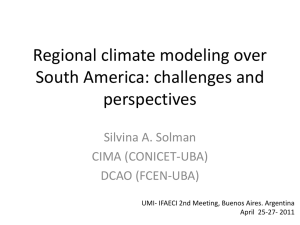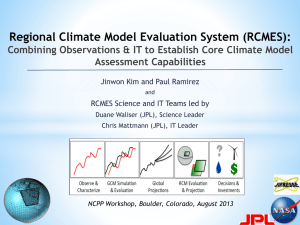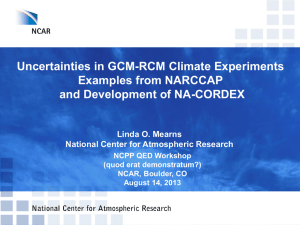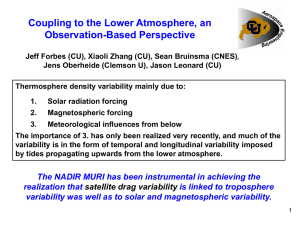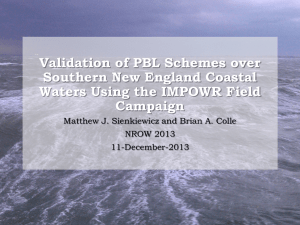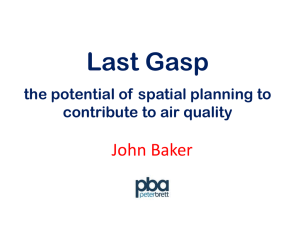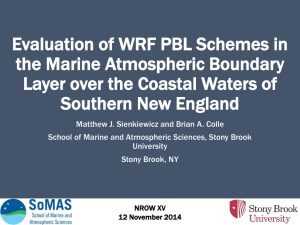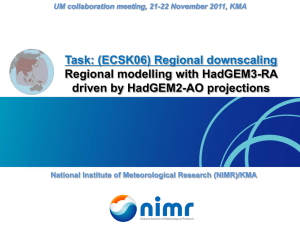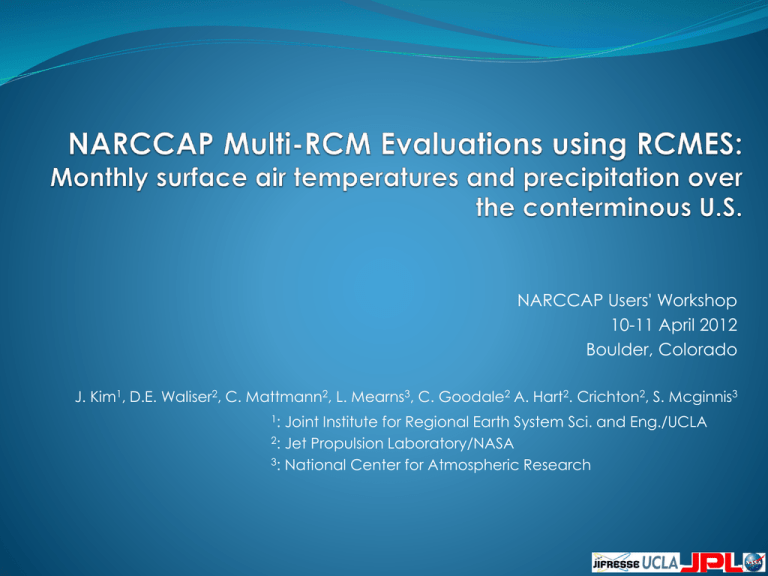
NARCCAP Users' Workshop
10-11 April 2012
Boulder, Colorado
J. Kim1, D.E. Waliser2, C. Mattmann2, L. Mearns3, C. Goodale2 A. Hart2. Crichton2, S. Mcginnis3
1:
Joint Institute for Regional Earth System Sci. and Eng./UCLA
2: Jet Propulsion Laboratory/NASA
3: National Center for Atmospheric Research
Background: Regional Climate Model Evaluation
Recent studies have confirmed with high level of confidence that the
emissions of anthropogenic greenhouse gases have induced the ongoing
global warming trend.
Assessment of the impacts of climate change on regional sectors have
become an important concern.
RCMs play a crucial role in climate change impact assessments.
Systematic evaluations of GCMs have been undertaken for some time
(e.g., AMIP, CMIP); this is not the case for RCMs.
JPL Regional Climate Model Evaluation System (RCMES)
Facilitate Model Evaluation via User-friendly Data Infrastructure
GCM Evaluation
C.C. Attribution
Observational data are a key component of climate research
Detection and attribution
Typical model evaluation is performed by comparing the model and
reference data from observations, analysis of observed data and/or
observation-based assimilations.
Easy access to quality reference data facilitates evaluation efforts.
Remote-sensing at NASA & other institutions can provide fine-scale reference
data suitable for evaluating future RCM simulations.
To facilitate RCM evaluation, especially for easy access to remote
sensing data, RCMES has been developed via joint JPL-UCLA efforts.
RCMES (http://rcmes.jpl.nasa.gov)
High-level technical architecture
user
choice
RCM data
URL
TRMM
Metadata
Data Table
MySQL
AIRS
Extractor
Soil
moisture
ETC
Raw Data:
Various formats,
Resolutions,
Coverage
Extract RCM
data
Data Table
MODIS
SWE
Extract OBS data
Regridder
Put the OBS & RCM data on the
same grid for comparison
Data extractor
(Fortran binary)
Data Table
Data Table
Metrics Calculator
Calculate comparison metrics
Data Table
Data extractor
(Fortran binary)
Data Table
Common Format,
Native grid,
Efficient architecture
RCMED
(Regional Climate Model Evaluation Database)
A large scalable database to store data from
variety of sources in a common format
Visualizer
Plot the metrics
RCMET
(Regional Climate Model Evaluation Toolkit)
A library of codes for extracting data from
RCMED and model and for calculating
evaluation metrics
User’s
own
codes
for
ANAL
and
VIS.
RCMES Database (RCMED)
Current & near-future archives
RCMED Datasets (now or near-term)
MODIS Cloudiness: [2000-2010, daily]
TRMM PR: [1998-present, daily], 3B42 & version-7
AIRS TSFC and profiles: [2002-2010, daily]
NCEP CPC PR analysis: [1948-present, daily, US]
CRU v3.0 & v3.1 (pr, T2, T2MAX, T2MIN, cloudiness): [monthly]
JPL SWE: [2000-2010], Sierra Nevada
CERES Radiation: [1983-2007, monthly], surface and TOA
NASA MERRA Reanalysis
ERA-Interim Reanalysis
NCEP Reanalysis
CloudSat, MISR/MODIS aerosol, SMAP SMC, etc.
RCMES
Ongoing and planned application
Near-term applications to WCRP’s CORDEX for IPCC
•
•
•
•
•
N. America: Funded via NASA for U.S. NCA (NCAR, NARCCAP)
Africa: Collaboration & analysis ongoing (UCT, Rossby Centre)
Arctic: Exploring collaboration (J. Cassano, March 2012 Workshop)
E. Asia: Exploring collaboration (KMA, APCC)
S. Asia: Exploring collaboration
NARCCAP
AFRICA
Not Illustrated Here:
Arctic & Antarctic Domains
S. Asia
E. Asia
NARCCAP Multi-RCM Evaluation:
Monthly precipitation and surface air temperatures
The JPL-UCLA team is collaborating with NCAR scientists for providing
inputs to National Climate Assessment report.
Monthly data from 5 RCMs for the 24-year (1980-2003) period are
obtained on a common grid from NCAR.
Evaluations are performed for the monthly-mean values of:
Precipitation and the daily-mean surface air temperature
Reference data used:
CRU3.1 (1901-2010, 0.5deg)
Currently WIP:
Surface pressure (vs. MERRA Reanalysis data)
Surface insolation (vs. CERES radiation data)
RCMs and the Analysis Domain
•
The data from 5 RCMs and their ENS
over the conterminous US region are
evaluated.
•
The RCM simulations are interpolated
onto a common grid nest of 0.5-deg
horizontal resolution for analysis,
evaluation, and inter-comparison.
•
Fourteen sub-regions (as shown in the
figures and table) are selected to
examine model performances in
various regions of interests.
Model ID
M01
Model Name
M02
CRCM (Canadian Regional Climate
Model)
ECP2 (NCEP Regional Spectral Model)
M03
MM5I (MM5 – run by Iowa State Univ.)
M04
RCM3
M05
WRFG (WRF – run by PNNL)
ENS
Model Ensemble (Uniform weighting)
[1] The daily-mean surface air temperature evaluation
5 RCMs and their ensemble vs. CRU3.1 analysis
• 24 years: 1980-2003
• Overland only
• Annual climatology: Spatial variability
• Seasonal climatology: Interannual variability
• Annual cycle in subregions.
Daily-mean surface air temperatures:
Climatology and Biases
•
Model errors varies systematically
according to geography.
•
All models show cold biases over the
coastal and the eastern US regions.
•
Most models show warm biases in
the Great Plains region.
•
Model errors in the mountainous WUS
region vary widely; may be related
with large orographic variations in
the region.
–
RCMs may experience difficulties in
simulating the surface air
temperatures in the mountainous
WUS with their 50-km horizontal
resolutions.
Surface air temperature climatology:
Spatial Variability over the land surface
•
Evaluation of the spatial variability of
the simulated surface air temperature
climatology using the Taylor diagram
–
–
–
Spatial pattern correlations
Spatial variability
RMSE
•
All models generate spatial patterns
reasonably with pattern correlation
coefficients of 0.95-0.99 with the CRU
analysis.
•
The simulated spatial variability is also
close to the observations.
–
–
•
The standardized deviation ranges from
0.9 to slightly above 1.
All models except CRCM underestimate
the spatial variability.
The model ensemble (marked by a red
circle) yields the smallest RMSE.
Seasonal surface air temperature climatology:
Normalized bias & interannual variability
(a) Bias (% the CRU STDDEV)
•
(b) Standard deviations (% the CRU STDDEV)
Mean biases vary, quite systematically, according to geography and season
–
–
–
Warm biases in the Great Plains area for both summer and winter
Cold biases in the Pacific, Gulf, and Atlantic coast regions in summer
Warm biases in the Atlantic coast, Florida and northern California during winter.
•
All models reasonably simulated the interannual variability of the winter
temperatures in most regions.
•
The interannual variability are generally overestimated for summer temperatures.
•
The model ensemble is among the best performers for all seasons, regions, and
metrics.
[2] Precipitation evaluation
5 RCMs and their ensemble vs. CRU3.1 analysis
• 24 years: 1980-2003
• Overland only
• Annual climatology: Spatial variability
• Seasonal climatology: Interannual variability
• Annual cycle in subregions.
Annual precipitation:
Climatology and Biases
•
Model biases in simulating the
annual precipitation climatology
also varies according to regions.
•
The most noticeable systematic
biases are:
– wet biases in the Pacific NW.
– dry biases in the Gulf coast and
southern Great Plains.
– model biases are mixed in the AZ western NM region that is strongly
affected by the North American
Monsoon (NAM)
Annual precipitation climatology:
Spatial Variability over the land surface
•
All models show similar
performance in simulating spatial
patterns with spatial correlation
coefficients of 0.75-0.85 with the
CRU analysis.
•
Model performance vary more
widely in simulating the spatial
variability.
– Three out of five models as well as
the model ensemble
underestimates the spatial
variability.
•
The model ensemble (marked by a
red circle) yields the smallest RMSE.
Seasonal precipitation climatology:
Normalized bias and interannual variability
•
•
•
•
Winter precipitation:
– Most models overestimate the mean and interannual variability in the inland regions.
– Most models underestimate the mean and interannual variability in GC.
– Most models perform well for the Pacific & Atlantic coast regions.
Summer precipitation:
– Models generally underestimate the mean in the GP, SWUS, and FL.
– Models generally overestimate the mean in the Atlantic coast and Colorado regions.
– Large errors in the PNW and CA regions may not be of practical importance.
Model errors show strong regional variations.
Model errors in the seasonal mean and interannual variability are closely related:
– overestimations (underestimations) of the mean is usually corresponds to overestimations
(underestimations) of the interannual variability, especially for winter.
Summary
Evaluation of climate models is a fundamental step in projecting future climate and
assessing their impacts on important sectors.
JPL/NASA is developing RCMES to facilitate RCM evaluation
A number of observed and remote sensing data are available for model evaluations
Monthly-mean surface air temperatures and precipitation from multiple RCMs
participating in the NARCCAP hindcast experiment have been evaluated.
It has been found that model errors vary systematically according to regions, seasons,
variables, and metrics in addition to models.
Models generate warm and cold biases in the GP and the coastal regions, resp.
The warm biases in the GP region occur in both summer and winter.
In other regions, biases vary according to seasons.
All RCMs generate wet and dry biases in the PNW and GP regions, resp.
All RCMs perform poorly in simulating the summer precipitation in the SWUS region.
Overestimations of seasonal mean precipitation is usually accompanied by
overestimations of interannual variability.
The simple model ensemble is typically among the best performer in all evaluations.
The model errors identified in this study can be related to multiple causes including:
The lack of horizontal resolution, model physics, errors in reanalysis data
Need in-depth process studies to identify the causes of model errors.

